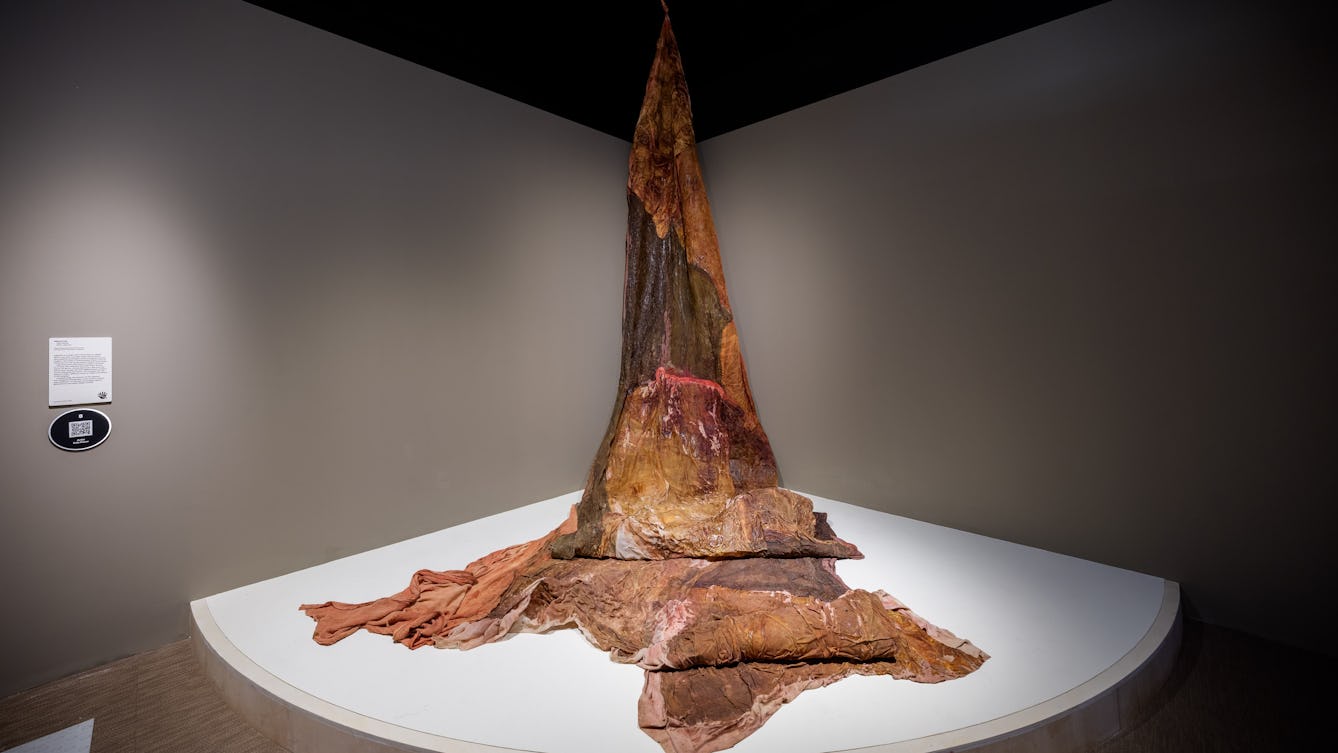When facing the QR code for this stop, the artwork is on a low semi-circular white plinth directly to your right. There is also a bench behind you. The bench is upholstered in a light blue fabric with a grey metal back.
I’m Dala Nasser, the creator of this work, ‘Mineral Lick’.
A 4 m-long drape of fabric descends down from a single point in the ceiling, its lower portion spilling out along the ground towards you. It is made up of 60 pieces of cloth, stitched and taped together, each piece tinted ferrous shades of red, earthy yellows, and patches of sickly green and brown. Its texture resembles folds of skin. Its wrinkled surface is covered in latex, giving it a slick sheen. Called ‘Mineral Lick’, it could almost be a tongue.
I made this piece in 2019 while I was living in Beirut, Lebanon. This was after the ‘Trash Crisis’ of 2015, where the governmental failures reached a head in the summer. Trash stopped being collected and started piling up on our streets. The stench of rotting garbage plagued us, and uprisings against the corrupt political class occupied our summer. We were afraid of the coming rain, knowing that our failed infrastructure wouldn’t protect us from trash seeping into our faucets.
This summer stayed with me, and I began producing works inspired by the protests that took to our streets sketching out visions for another future. As rampant privatisation affected our daily lives and spaces of living, everything in the city became difficult to access.
Fifteen years of civil war will do that to a city, I suppose, but the war had ended in 1990, the year I was born. So why was it that Lebanon, the most water-rich nation in the region, still had undrinkable tap water?
I thought of a very simple science experiment. I remember my best friend’s tap water was extremely salty, but I lived closer to the sea than she did. So I thought: Let me divide the map into the 60 different neighbourhoods of Beirut, collect tap water from each, and do a very basic test.
I immersed fabric in equal parts salt and tap water and then boiled it. The salt completely dissolves in the water, and when you take the fabric out, it sprouts salt crystals.
I wanted to test the pH of the tap water to see which was the saltiest, or the most acidic. I duct-taped the pieces of fabric together and covered them with liquid latex. That's how you get the effect where it looks like a curtain that’s still in motion. Some pieces of fabric have this glittery sheen on the surface, where the salt crystals have sprouted out of it.
Each piece of fabric bears witness to one of the 60 neighbourhoods that the water came from. It’s a hydromap of Beirut. One that is embedded within our bodies. This is why I used latex, as it acts as a second skin, like human flesh. I wanted it to evoke an abattoir – how they hang a carcass. As I was working on the composition, I moved beyond geography and started thinking about the body and the self. This is the water that’s coming into our bodies in the that city we live in.
In Lebanon, nobody can drink the tap water. Instead, there’s a private water industry that fills in for the government’s failures. Most likely, these private companies are owned by members of the government too, so the cycle of corruption and laissez-faire privatisation continues.
The evening I first showed this work in Beirut was the night the October 2019 protests started. People took to the streets to rise up against the government for imposing a heinous phone tax. Like in 2015, the hopes for another future took over us. The exhibition closed that evening in solidarity with the protesters.
At some point it rained and the rainwater seeped into the museum and soaked the bottom half of the work. The watermarks are still visible in the fabric to this day. This work is supposed to represent water and infrastructural failure, and it fully endured it.
This is the end of Stop 8.
